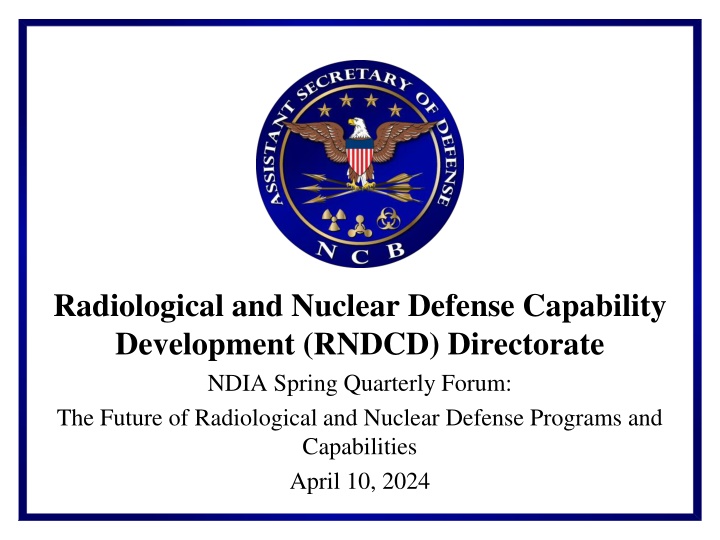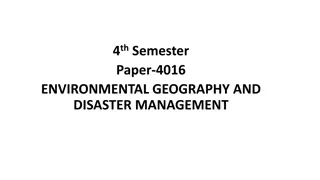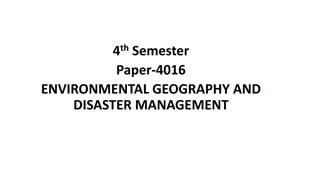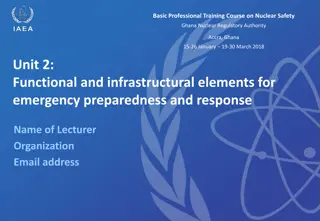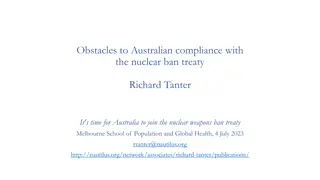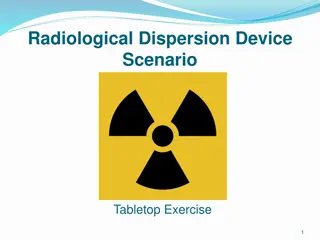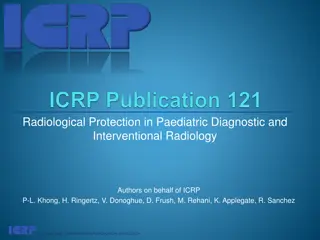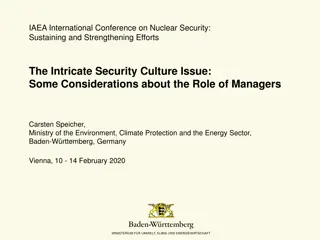Future of Radiological and Nuclear Defense Programs and Capabilities
The Radiological and Nuclear Defense Capability Development Directorate discusses the responsibility for modernizing and procuring defense capabilities in the face of radiological and nuclear threats. The Department of Defense outlines strategic priorities to ensure the ability to survive and prevail in potential nuclear warfare scenarios, emphasizing the importance of detection, identification, and operational effectiveness in radiological/nuclear environments. The RNDCD's mission statement focuses on enabling the Joint Force to operate effectively in R/N environments by providing modernized equipment for threat detection and identification. The program overview highlights the investment in advanced research, development, testing, and procurement of equipment to enhance DoD's ability to navigate threats and conflicts across various domains.
Download Presentation

Please find below an Image/Link to download the presentation.
The content on the website is provided AS IS for your information and personal use only. It may not be sold, licensed, or shared on other websites without obtaining consent from the author.If you encounter any issues during the download, it is possible that the publisher has removed the file from their server.
You are allowed to download the files provided on this website for personal or commercial use, subject to the condition that they are used lawfully. All files are the property of their respective owners.
The content on the website is provided AS IS for your information and personal use only. It may not be sold, licensed, or shared on other websites without obtaining consent from the author.
E N D
Presentation Transcript
Radiological and Nuclear Defense Capability Development (RNDCD) Directorate NDIA Spring Quarterly Forum: The Future of Radiological and Nuclear Defense Programs and Capabilities April 10, 2024
Office of the Secretary of Defense * Responsibility for modernizing and procuring radiological and nuclear defense capabilities, to include detection and identification, delegated to DASD(TRAC) by ASD(NCB)
DoD Guiding Strategic Priorities DoD must be able to survive, fight, and prevail in the event that our adversaries employ radiological or nuclear weapons on or near the Joint Force. (NSS) Part III: Our Global Priorities: The United States will not allow Russia, or any power, to achieve its objectives through using, or threatening to use, nuclear weapons. (NDS) Deterring Strategic Attacks: synchronizing conventional and nuclear aspects of planning including by improving conventional forces ability to operate in the face of limited nuclear, chemical, and biological attacks so as to deny adversaries benefit from possessing and employing such weapons. (CWMD Strategy): - Enable the Joint Force to prevail in a CBRN-contested environment. - Build a Joint Force that can campaign, fight, and win in a CBRN environment. [DoD must] recapitalize, and in some cases reconstitute, its ability to conduct large-scale joint operations within a WMD- contested battlespace. (NPR): the Joint Force must be able to survive, maintain cohesion, and continue to operate in the face of limited nuclear attacks. Further development of plans and force requirements to enable military operations in a nuclear environment will be a focus of NPR implementation 4
Radiological and Nuclear Defense Capabilities Development (RNDCD) Mission Statement: Enable the Joint Force and National Guard Bureau to operate in a radiological or nuclear (R/N) environment by providing modernized detection and identification equipment. Vision Statement: A Joint Force and National Guard Bureau that can detect and identify R/N threats and operate effectively in an R/N environment. Deliverables: R/N capabilities the Joint Force can leverage to address current and future threats, delivered through rapid fielding of innovative, cutting-edge technologies in a cost effective and streamlined process. 5
RNDCD Program Overview Enhance DoD s ability to campaign across the domains of threats and spectrums of conflict by improving the Department s capability to survive, fight, and prevail in an R/N environment. WHAT WE DO Invest in validated requirements by resourcing and advocating for advanced RDT&E, and procuring R/N equipment to support the National Guard Bureau and special end users with limited procurement dollars. HOW WE DO IT Enables protection of the Joint Force in a R/N environment; serves as a central node for R/N defense development reducing duplicative efforts; accomplishes NDS and CWMD Strategy objectives by building R/N defense capabilities within the Joint Force and National Guard Bureau WHY IT MATTERS Joint Force, National Guard Bureau, Combatant Commands, Defense Agencies, Industry Partners STAKEHOLDERS 7
R/N Mission Space Defend the Homeland Prevail in a CBRN Environment Deter WMD Attacks Prevent New WMD Threats Elimination Passive Defense Interdiction Consequence Management Forensics R/N Standoff Isotope Identifiers Manned Platform Mounted Unmanned Platform Mounted R/N Standoff Telescoping Remote Detection Isotope Identifiers Telescoping Remote Detection Wide Area Search Alternative Signatures Area Detectors Collective Protection (4.g.6) Warning & Reporting Unmanned Platform Mounted Sample Collection Contamination Mitigation Fixed Site (4.g.5) Man-portable X-ray Render Safe Sample Containment & Handling Contamination Mitigation Equipment Contamination Mitigation Fixed Site (4.g.6) Portal Monitoring Continuous Air Monitoring Thermal/Flash Protection Attribution Geo-Physical Detection Geo-Physical Detection Shielding (4.a) Decision Analysis & Management Contamination Mitigation - Personnel Respiratory & Ocular RN Protection (4.a) Bio/Internal Dosimetry (4.a) Contamination Monitoring (RDS) R/N Medical (4.a)
A Phased Approach TRAC will use a phased approach to implement R/N investment Phase 1, FY24-27: Improve detection capabilities across the Joint Force to meet near term readiness requirements Complete development and enable fielding of existing validated Joint Force capability requirements Develop and publish RNDCD Charter that establishes roles between ODASD(TRAC), CCMDs, Services, JRO-CBRND, DTRA, and NGB to review and prioritize near term capability gaps and develop FY 26-30 POM recommendations for ASD(NCB) Phase 2, FY27-30: Institutionalize RNDCD processes and ensure Joint Force RND readiness If justified through cost-benefit analysis and supported by DoD Components, expand the research and development program beyond detection/identification capability requirements Refine/update RNDCD Charter and incorporate capability development methodologies that will accelerate acquisition; define synchronization processes to leverage existing DTRA funding for S&T investments for emerging requirements Develop and publish a RNDCD DODI Assess future capability development efforts against mid-term Joint Force readiness requirements Phase 3, FY30 and beyond RNDCD institutionalized, right-sized, and providing necessary RND capabilities to support NDS 9
RNDCD Partners Key Stakeholders Military Services (Army, Navy, Marine Corps, Air Force) National Guard Bureau Defense Agencies and Developmental Centers Defense Threat Reduction Agency (DTRA) Armed Forces Radiobiology Research Institute (AFRRI) Joint Program Executive Office for Chemical, Biological, Radiological, and Nuclear Defense (JPEO-CBRND) Naval Information Warfare Center (NIWC) Naval Air Warfare Center Aircraft Division (NAWCAD) Industry Partners Various, mostly interfacing with DTRA on early development efforts 10
